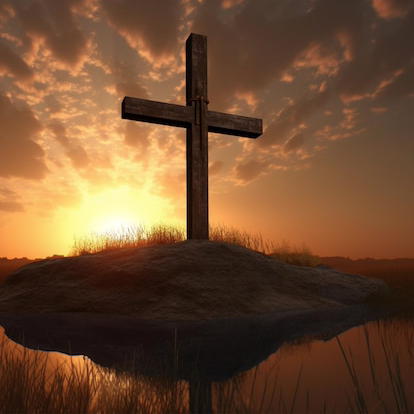TheCatholic said:
Yahoshea said:
.......John 20:28
What’s your point. Thomas looked at Christ and saw his lord or master/teacher and also saw his God that dwelled in him........
This time it is YOU who failed one of the most prudent aspects of proper interpretation: DON'T MAKE UP STUFF THAT ISN'T THERE.
Thomas did not look at Christ and say, "
My lord and also the God that dwells in you". LOL. Thomas said "
M y Lord and my God."
Very simple. You are just reading stuff into the text that isn't there to suit your own purpose.
Jesus is God. The scriptures prove it time and again, and he says it from his own mouth
I just noticed your screen name. I assume you are catholic. that explains why you believe what you do. Here is a little actual history of your church's doctrine.
In the preface to Edward Gibbon's History of Christianity, we read: "If Paganism was conquered by Christianity, it is equally true that Christianity was corrupted by Paganism. The pure Deism of the first Christians was changed, by the Church of Rome, into the incomprehensible dogma of the trinity. Many of the pagan tenets, invented by the Egyptians and idealized by Plato, were retained as being worthy of belief."
Alexander Hislop, in his TWO BABYLONS, seems to trace the various ideas of the trinity back to a common heritage. Hislop pointed out the antiquity of the theological concept of the Trinity by giving examples of pagan trinities in Siberia, Japan, and India. He noted that the recognition of the Trinity was “universal in all the ancient nations of the worldâ€. He went so far as to say that “the supreme divinity in almost all heathen nations was triuneâ€. While Hislop was attempting to prove that mankind has always believed in a “trinityâ€, he also unwittingly shows the pagan origins of the idea of a “trinityâ€
The trinity is noted in connection with the construction of the Tower of Babel. Diodorus Siculus, in his Bibliotheca, states that in the topmost completed story of the Tower was placed the images of three gods.
Trinitarians today may argue that the pagan trinities were completely different from the model of the Christian Trinity. But some pagan triads have structures which are surprisingly familiar. For example, the Hindu Trinity:
The conception most closely linked with Vedism and Brahmanism is that of the Hindu Trinity, the Trimurti. ‘The Absolute manifests himself in three persons, Brahma the Creator, Vishnu the Preserver, and Shiva the Destroyer’.
-Asiatic Mythology
The Egyptian triad of the sun god was “one god expressed in three personsâ€. He was known as the “noonday sun†(Ra), “the evening sun†(Tum), and “the dawning sun†(Khepera). The sun god reportedly said, “Lo! I am Khepera at dawn, Ra at high noon, and Tum at eventideâ€. He was one god in three distinct persons.
Clearly it is not correct to say that the structure of pagan trinities do not resemble the Christian Trinity.
Other ancient cultures also had Trinities to describe their Gods. In Phoenicia the trinity of gods were Ulomus, Ulosuros, and Eliun. In Greece they were Zeus, Poseidon, and Aidoneus. In Rome they were Jupiter, Neptune, and Pluto. In Babylonia and Assyria they were Anos, lllinos, and Aos. Among Celtic nations they were called Kriosan, Biosena, and Siva, and in Germanic nations they were called Thor, Wodan, and Fricco.
One of the sources of the doctrine of the Trinity in Christianity is Gnosticism and Dualism.
A one-sentence description of Gnosticism is; A religion that differentiates the evil god of this world (who is identified with the God of the Old Testament) from a higher more abstract God revealed by Jesus Christ, a religion that regards this world as the creation of a series of evil archons/powers who wish to keep the human soul trapped in an evil physical body. Gnostics conjured up the idea that Christ was a spiritual being in a physical shell in order to avoid the concept of him having an "Evil Physical Body of the “Evil physical realm".
Dualism is a Greek Philosophy that takes gnosticim even farther. It teaches there are two realms, one evil and one holy. Dualists believe that only the transcendental spiritual realm of God like forces is holy. The lower natural earthly realm was considered evil and nothing good could be of that world.
When Christianity spread to the Greek thinking world it was heavily influenced by their philosophies. Many students of Greek philosophy were being saved and as such brought their concepts into the church. As is often the case some so called “scholarsâ€, from this period forward, began to interpret scripture with preconceived ideas of a gnostic or dualistic world. From gnosticim came the concept of Jesus being a separate God from the God of the Old Testament. From Dualism came the concept that Jesus could never be fully of the natural realm or fully human. His humanity needed to be augmented in some way to avoid him being of the evil natural realm.
Dualism was contrary to Hebrew belief and culture. Hebrews thought of all creation as part of the kingdom of God. Because God was infinite they believed that God was an integral part of the physical realm and, in fact, revealed himself thru the natural world. To the Hebrews everything in the natural realm was in the presence of God and He overshadowed everyhing there.
Many early Christian leaders were influenced by Greek thinking.
Clement of Alexandria (150-213 AD), head of one of the early Christian schools, which was heavily influenced by philosophy and gnosticism, admitted that he was opposed by those who still considered philosophy “evilâ€. He made light of their opposition and said that they were light and “ignorantâ€. He denounced the “so-called orthodoxy who, like beasts which work from fear, do good works without knowing what they are doingâ€. But Clement, of course, knew what he was doing. He had a special gnosis (knowledge) that the ignorant “orthodox†did not possess.
Friedrich Ueberweg says that “Gnosticism was the first comprehensive attempt to construct a philosophy of Christianityâ€. The more flagrant gnostics, such as Cerdo, Cerinthus, Saturninus, and even Marcion, had been expelled from the church. These more flambuoyant gnostics were only the “tip of the icebergâ€. There was still a large remnant in the churches, who obviously began developing some philosophical system of Christianity that would compete, so they thought, in the Gentile world.
The apostle Paul was troubled with gnostics, and spoke against those who clung to “falsely-named science†(knowledge or gnosis) (1 Timothy 6.20).
20) Oh Timothy, guard what has been entrusted to you, avoiding worldly and empty chatter and the opposing arguments of what is falsely called knowledge (gnosis)
21) which some have professed and gone astray from the faith.
Paul says that gnosis/gnosticism causes a falling away from the faith.
Gnosticism and dualism had a foot in the door in the early church. Many founding fathers fought against it's beliefs and dogmas.
In the third century gnostics and their philosophy would get their greatest boost from the Emperor of Rome himself.
Constantine emperor of Rome had a problem. His kingdom was in turmoil because of strife between different religious factions. He had christians, gnostics, pagans, druids and many more. Constantine solved this problem by merging all these various factions together and forming The Holy Roman Catholic Church.
Following the example of his father and earlier 3rd-century emperors, Constantine throughout His life was a solar henotheist, believing that the Roman sun god, Sol, was the visible "manifestation" of an invisible “Highest God†{a plural God?} (summus deus), who was the principle behind the universe. Does this sound familiar? This god was thought to be the companion of the Roman emperor.
Constantine's adherence to this faith is evident from his claim of having had a vision of the sun god in 310 while in a grove of Apollo in Gaul.
In 325 AD - Constantine convenes the Council of Nicaea in order to develop a statement of faith that can unify the Church and therefore his empire. The Nicene Creed is written, declaring that "the Father and the Son are of the same substance" (homoousios). Let me point out that the substance of God is spirit therefor if Jesus is of the same substance then he was spirit and did not live in the flesh and therefor did not really die or be physically raised from the dead.
Emperor Constantine who was also the high priest of the pagan religion of the Unconquered Sun presided over this council.
According to the Encyclopedia Britannica:
"Constantine himself presided, actively guiding the discussions and personally proposed the crucial formula expressing the relationship of Christ to God in the creed issued by the council, `of one substance with the Father'."
The American Academic Encyclopedia states: "Although this was not Constantine's first attempt to reconcile factions in Christianity, it was the first time he had used the imperial office to IMPOSE a settlement." It is known that many of His former beliefs followed Him into Christianity and that those beliefs strongly influenced the Nicaea council. It is also clear that part of his motives for forming the Holy Roman Catholic Church were to unify his kingdom. It is therefor clear that the council of Nicaea had been called in part to find a way to unify the Roman Empire under a statement of Faith. This council is known for it's Nicaean Creed detailing the doctrine of the Trinity which is the first time God is officially described, in any church document or biblical manuscript, as separated into three, The Father, The Son and The Holy Spirit. It was there at Nicaea that the doctrine of the Trinity was rammed through in a Council that was overseen by the Emperor Constantine who, ironically enough, thought of himself as God-incarnate. (Constantine the Sun Worshiper only made an official conversion to "Christianity" on his death bed).
One of the early problems encountered by the followers of the Trinity doctrine was that of the nature of Christ. There are very clear scriptures that state that Jesus was a man. This was a problem because this was contrary to the original Trinity Doctrine that Jesus was a co-equal person of God and of the same substance. Jesus as a man also contradicted dualist who could never accept Jesus as fully human of the lower earthly realm. Future councils had the impossible task of defending the Trinity while at the same time dealing with these contradictions. Since no biblical proof could be found, their answer was to contrive the Dual Nature Doctrine, or 100% God and 100% man concept. This doctrine concludes that Jesus is fully man and Fully God at the same time.
There are no such words as Dual Nature or 100% man and 100% God in scripture. In fact the concept is conspicuously absent in any scriptural form whatsoever. Again we must ask ourslves, Where does this concept come from? Simply put these councils were hard pressed to find an answer to the contradictions found in the Trinity. With this in mind they formulated a doctrine with no scriptural proof and just applied it as truth. They went to the scriptures with this doctrine and applied scriptures out of context. By using unclear scriptures they could twist them to seem to validate their doctrine.
Since there are no clear scriptures to define this dual nature of Christ we must look elsewhere to determine it’s origin and history. This doctrine did not happen overnight, but took years to develop. The result was a cocktail of Irational and illogical thought leading to meaningless rhetoric. Let’s look at some of the history, by which this doctrine entered the teaching of the church.
Most of the primary tenants of the dual nature doctrine stem from several councils starting in 325 A. D. These councils were formed for the purpose of denouncing what was believed to be false doctrine and for instituting some central statements defining the faith. Unfortunately, as stated before, Christianity had been corrupted by Paganism and Greek philosophy and the councils reflected this influence. The Nicene council stated that Jesus was fully God in response to the Aryans who believed that Jesus was not God.
The Apollianarians Did not believe that Jesus was fully human, therefore the council of Constantinople (381 U.S.) declared he was fully human.
The Nestorianism group denied that Mary could be called the mother of God. They believed that Mary was only the mother of the human part of Jesus. The resulting belief dictated that there exists two Christ's, one divine and one human. In response to this the council of Effuses (431 A. D.) decreed That the two natures of Jesus are one and cannot be separated.
Many of those present at the Council Of Nicaea were opposed the doctrine of the Trinity. Even after the Nicene Creed, the Trinity was still hotly debated for decades and centuries. As the years passed and the power of the Catholic Church increased, no one dared argue against the established doctrines of the Church. Before long a multitude of non - scriptural practices began to emerge resulting in the dark ages and the inquisition.
If Nicaea just formalized the prevalent teaching of the church, then why all the conflicts? If it were the established teaching of the church, then you would expect people to either accept it, or not be Christians. It was not the established teaching, and when some factions, of the church, influenced by Constantine, tried to make it official, the result was major conflict. Constantine stopped the conflict by banishing those who appeased him and used his power to coerce others into adopting the doctrine. In fact Constantine had the chambers wherein the counsel met surrounded by solders to insure no one left or apposed him.
Constantine the Great unified a tottering empire, reorganized the Roman state, and set the stage for the final victory of his version of Christianity at the end of the 4th century. In one historic moment, under this ruler of non-Judeo-Christian background and with the influence of paganism and gnosticism, the traditional doctrine of the Trinity is formed.
Since the time of Constantine several councils have had the dubious task of defending the Trinity without any clear scripture evidence for support. Unfortunately, the same holds true today. The explanations of the Trinity and the dual nature have become even more confusing and less logical.








